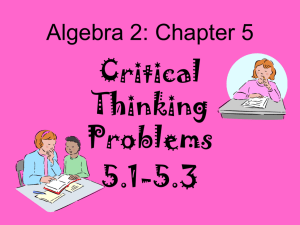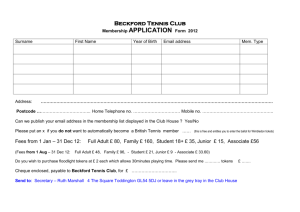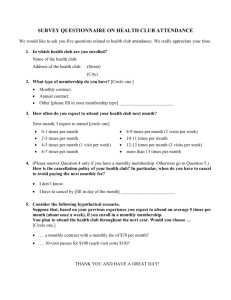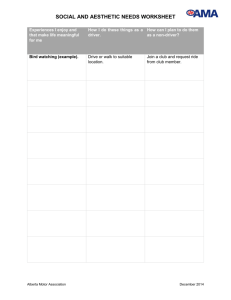PPT Slides
advertisement
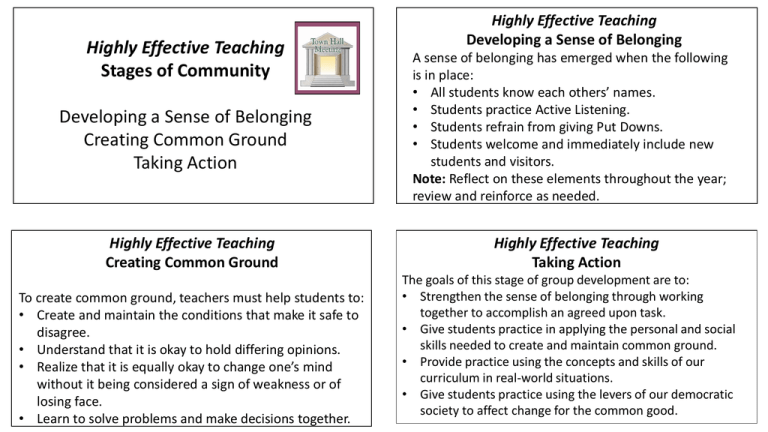
Highly Effective Teaching Stages of Community Developing a Sense of Belonging Creating Common Ground Taking Action Highly Effective Teaching Creating Common Ground To create common ground, teachers must help students to: • Create and maintain the conditions that make it safe to disagree. • Understand that it is okay to hold differing opinions. • Realize that it is equally okay to change one’s mind without it being considered a sign of weakness or of losing face. • Learn to solve problems and make decisions together. Highly Effective Teaching Developing a Sense of Belonging A sense of belonging has emerged when the following is in place: • All students know each others’ names. • Students practice Active Listening. • Students refrain from giving Put Downs. • Students welcome and immediately include new students and visitors. Note: Reflect on these elements throughout the year; review and reinforce as needed. Highly Effective Teaching Taking Action The goals of this stage of group development are to: • Strengthen the sense of belonging through working together to accomplish an agreed upon task. • Give students practice in applying the personal and social skills needed to create and maintain common ground. • Provide practice using the concepts and skills of our curriculum in real-world situations. • Give students practice using the levers of our democratic society to affect change for the common good. Ball Toss Highly Effective Teaching Building a Sense of Belonging Non Verbal Introduction Students work in small groups. Each individual thinks of a hobby they enjoy and what they look like when engaged in this hobby. At the signal, students non-verbally act out their hobby using movements, pictures, gestures, visuals while others are guessing what the hobby is. Note: Have students discuss with their groups: How accurate were you in describing yourself and “reading” others? What were the better clues given? What were the challenges? Standing in a circle, one person has the ball gains eye contact with another, says name of that person, and tosses the ball (underhand gives more control), to him/her. Students who have caught the ball put hands behind back so all know who has been called. Continue until all have tossed and caught the ball. Repeat, following same pattern, increasing the speed each time. Eventually add more balls for more challenge. Reflection: Did you enjoy this activity? Why? Why not? How did we help each other successfully do this? Appointment Schedule Students draw a clock on a piece of paper with a line next to at least 4 numbers (example: 12, 3, 6, 9). At the signal, they move around the room and write another person’s name next to each number and answer a given question. Note: This strategy can be used many ways– it is a good way for students to introduce themselves to others the first weeks of school. Questions asked can be more personal (favorite book, movie, etc.) at this time. Later use the same strategy as a review strategy by asking content questions. Trading Places Spotlight Students reflect on their travels, hobbies, and interests. They then write one experience on a Post-It note and attach it to their clothing. Next, they mingle in the group and read others’ notes related to hobbies. If both agree, they may trade notes with others that represent something they would like to do. Students sit with Learning Clubs in a circle. One person is in the “hot seat”. Each individual in the Learning Club gets 3060 seconds to give positive acknowledgements to the person in the “hot seat.” The listener remains silent or says only, “Thank you.” Eventually rotate the circle so each person has an opportunity to be in the “hot seat.” Note: During a Town Hall Meeting have some students share why they made the trades. Note: It is important that students can be trusted to be respectful prior to engaging in this activity. Oh K! In groups of 5-8Stand in a close circle– • Without discussion, in random order, and one person at a time, say the letters of the alphabet from A to K. • If two people say the same letter at the same time, begin again with “A”. • When your group reaches the letter K, join hands, raise them and say, OK! • Discuss strategies you used. Note: Also consider counting, multiplying, etc. Bookmarks Select your bookmark and write your name on one side. On the other side, write or illustrate: • Top: a LIFESKILL personal strength. • Middle: important people in your life. • Bottom: a personal goal you have for this week. Briefly share your bookmark with your Learning Club. Use the bookmark to mark important reading this week. Note: Consider providing “ET” (Extra Time) activities for early finishers. In this case it might be- Illustrate what your goal might look, sound or feel like. Highly Effective Teaching Small Group Reflection & Discussions Round Table Students sit in small groups- each individual has their own sheet of paper and a different color pencil. The question or topic is presented, students take turns writing about the topic or answer the question, passing the paper, in order, to the next person. Note: To extend learning and promote collaboration, give students an opportunity to share their paper with at least one other individual. Round Robin Students sit in small groups, teacher poses a question, students share, talking one at a time. Note: Keep a “sharing pass” (a ball, talking stick, even a pen) at each Learning Club. Initially give direction for who will share first (Example: student wearing the most blue) and which direction sharing pass should travel. Eventually give students an opportunity to make these decisions. Talking Chips Each student gets equal number of pennies or other tokens. Discussion topic is introduced. Each time one speaks, s/he pays a penny to the center of the table. Students must spend all money/tokens, but can’t talk after their money is spent. Note: If students need to move at this time, have them carry money/tokens, walk around the room, stopping to discuss the topic/question with others and put tokens in a designated location each time they speak. Numbered Heads Together Tables where students are sitting are numbered. Students number off at their table groups before discussing a topic. All are accountable for information. Roll dice and call table and person number to respond. Dice Discussion Each group has a die. Students take turns rolling the die and discuss a question (teacher-developed) based on the number rolled. Note: If student is unable to immediately answer, allow them to very quickly check in with Learning Club for an answer/hint. Note: Another alternative is to use suits and numbers on playing cards. Questions and discussions that require in-depth thinking and have more than one answer will encourage more sharing. Listen in as students share to decide whether extended reinforcement is necessary. Fan and Pick Jigsaw Write questions on cards. One student fans, another picks, another answers, the fourth shares an appreciation. (Rotate roles) Note: Once you have taught students how to ask good questions, let them write questions on cards as they are reading topic/skills-related materials. Assign four topics (Example: four different landforms). Each group member chooses a different one. Members “jigsaw out” to research their topic and “jigsaw back” to share information. Note: Consider individual accountability as you plan for this. Possible products could be large cutouts of a puzzle, pages of a book, parts of an immersion wall. Each “piece” should require some writing. Highly Effective Teaching Whole Group Reflection and Discussions Scholar’s Stroll Students are given a question or topic to discuss. Partners number off, 1 and 2. Walk the perimeter of the classroom (playground, gymnasium or…). Partner 1 discusses material while 2 listens and asks questions until the signal is given. Reverse roles after the signal. Note: Teacher listens in as students walk and talk. Ask 2-3 groups to share a key point after partners have had an opportunity to talk. Inside/Outside Circle Make two circles with students facing a partner. Partners turn so left shoulders are close. Leader calls out a number (example: 4), students walk to the fourth person in front of them, face each other and give a “high five”. Leader presents a question which partners discuss. At the signal, partners stop talking, thank their partner and listen for the next number, repeating the process. Gallery Walk Questions are posted on large sheets around the classroom. Small groups of students move together, read and respond to questions using a different color pen for each group. Leader signals time to move to the next question when appropriate. Note: This strategy can also be used when students are involved in or have completed a product from which their peers can gain insight. Take Ten Steps After direct instruction that has students sitting for a while, direct them to stand up and take 10 steps away from where they are sitting then pair up with a person they haven’t worked with lately. They then stand, walk, or sit and discuss the posed question. At the signal, they take more steps or go back to their seats. Note: Questions that require in-depth thinking and have more than one answer will encourage more thinking. Shuffle After significant content has been taught, students discuss the topic then number off in groups. All numbers 1 and 3 stand and “shuffle” to different groups where there is new sharing. Students then go back to their groups and share what they discussed during Shuffle. Note: For older students, this can be called “Content Coffeehouse” Appointment Schedule Students draw a clock with a line next to at least 4 numbers (example: 12, 3, 6, 9). At the signal, they move around the room and write another person’s name next to each number. When their Appointment Schedule is full, they take their seat. Note: This strategy is especially effective when students need a break and have important information to discuss. It’s Snowing! Each individual needs 1 piece of paper (scratch is fine) and 1 pencil. • After content has been taught and inquiries have been completed, each individual writes one way they can apply this information in their life, crumples the paper and tosses it into a circle. • Another individual picks up a paper, reads it, looks for a connection to their learning and adds another idea. Note: Students can fold paper in ¼ and write something they learned in ¼, toss, and next person writes what they learned; repeat x4. Pair-Shares Highly Effective Teaching Individuals Teach content or give students an opportunity to research or read about a topic of study. Ask questions then encourage students to Think, Write, or Draw their answers and share with a partner. “Show You Know” Note: This works well as a “scaffolding” strategy for English language learners or others who are unfamiliar with the content. Quick Shows Ask a question and get a sense of student-understanding as they “show” their individual opinions/answers by: • Sitting Down • Standing Up • Showing Thumbs Up/Thumbs Down • Nodding or Shaking Head Be creative! Note: Effective with yes/no, true/false, and agree/disagree– closed questions. White Boards Ask an open question that requires extended thinking. Give students time to think, write, and show their answers. Note: Help students organize for this strategy so it doesn’t take lots of time to gather boards, pens, and erasers. Old socks make great erasers- have students put their pen in their sock as they put boards away. Show Me the Number Sign or Signal Students show the answer to a prompt by showing with their body, hands, face, etc. Assign numbers to vocabulary or spelling words, places on a map, etc. Ask a question or give a clue and ask students to show you the number of the correct answer. Note: Allow students to create movements that represent words or ideas then discuss, revise, and teach these to others. Many will quickly learn new vocabulary through movement. Note: As you ask a question or give a clue, let students first think, then whisper the answer to a partner prior to writing the number on their board; thus making success possible for all. Resident Expert Select one “expert” from your Learning Club. • The “expert” will select a topic from one of the centers, announce the topic to the Learning Club, and then go study it. • The remaining club members will create questions to ask the “expert.” • Finally, the group visits their expert at the station to ask the questions. Note: Learning Clubs then reflect on their experience and take turns assuming each role. Personal Best Gallery Walk After beginning a project allow students to walk around the room to see how other students are doing their personal best work. Allow them to go back to their projects and use the best ideas they saw to improve their own work. Note: Ask students to reflect on this by asking questions such as: How did Gallery Walk affect the quality of work you ultimately did? How does it feel to share your ideas with others? How did you improve on the ideas you saw used by others?

